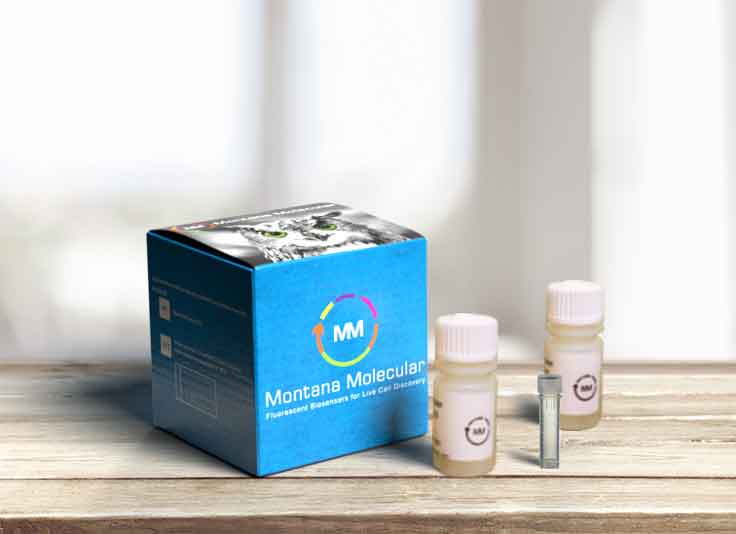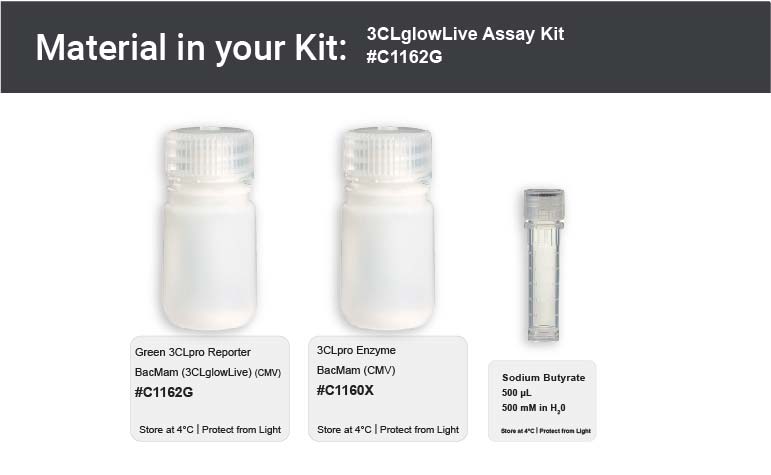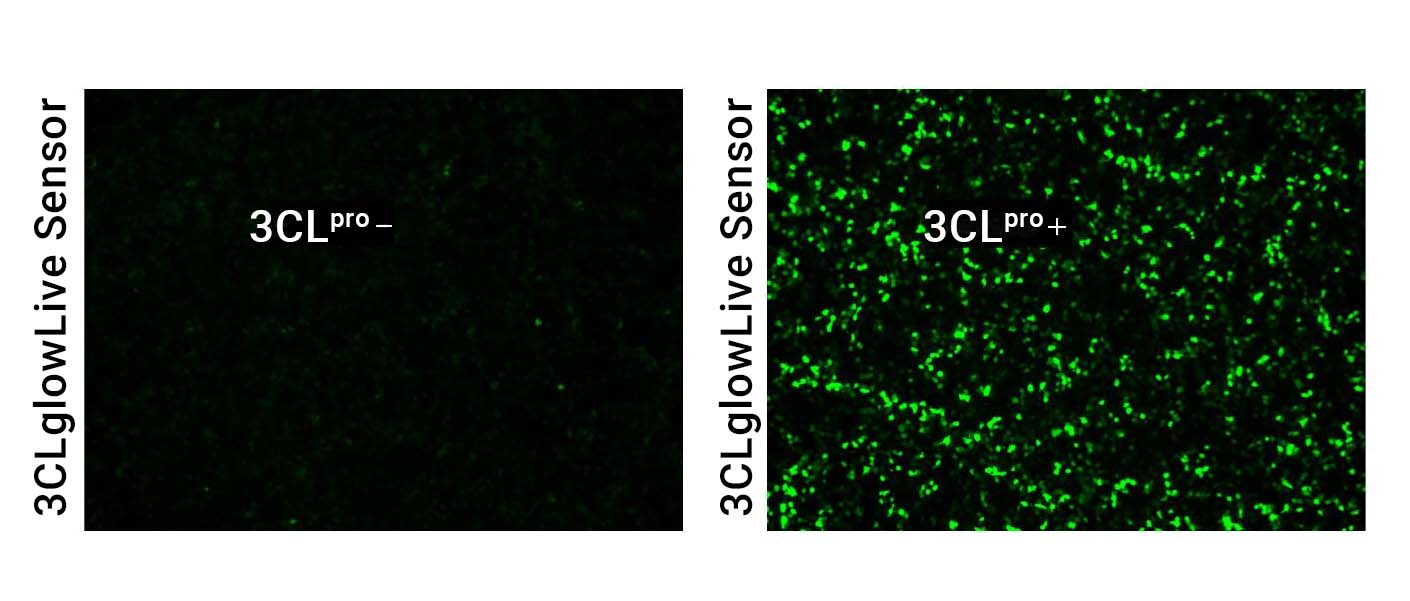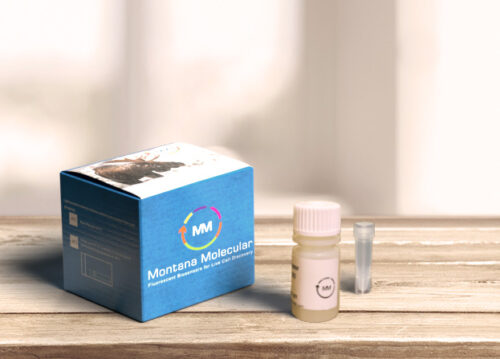3CLglowLive Assay (C1162G)
Price range: $695.00 through $3,895.00
A live cell assay for SARS-CoV-2 3CLpro enzyme activity, well-suited to experiments using live SARS-CoV-2 virus.
SARS-CoV-2 assays and reagents
3CLglowLive 3CLpro (Mpro) Activity Assay
The 3CLglowLive Assay kit is well suited to experiments using the live SARS-CoV-2 virus. It is dim at baseline but fluoresces green in the presence of 3CL protease activity, an indicator of SARS-CoV-2 viral replication. The kit includes 2 BacMam viruses - one expressing the 3CLglowLive biosensor and the other a 3CLpro enzyme, which could be used to test the biosensor and optimize fluorescence detection settings.
- Rapidly identify SARS-CoV-2 replication in living cells
- Sensor is dark at baseline, providing minimal background fluorescence
Materials in the Kit:
• Green Fluorescent 3CLpro reporter in BacMam (3CLglowLive)
• 3CLpro Enzyme in BacMam
• Sodium Butyrate, 500 mM in H2O
Additional information
| Shipping | We strive for prompt delivery of each order, so we ship by FedEx 2-day service in lightweight, sturdy, and reusable/biodegradable packaging with an insulated cooler and moisture-resistant refrigerant gel packs. Shipping days are Mon-Wed so product does not sit in transit over the weekend. Web store ships to US & Canada only, contact sales for other locations. |
|---|---|
| Protocol for Use | Coming Soon |
| MSDS | |
| Kit Volume | 5mL, 30mL, 60mL |
| More Info |
COVID-19 tools Publications
Pseudovirus and Host Factor Publications
- M.T. De Sibio, et al. Irisin Attenuates SARS-CoV-2 Entry Into Cells and Cell Damage in 2D and 3D Cultures of Human Subcutaneous Adipocytes. Endocrine Connections. July 2025.
- V. Fuochi, et al. Disrupting SARS-CoV-2 Spike–ACE2 Interactions via Glycosaminoglycans in a Pseudoviral Study of Heparan Sulfate and Enoxaparin. biomolecules. June 2025.
- V. Fuochi, et al. Antiviral efficacy of heparan sulfate and enoxaparin sodium against SARS-CoV-2. Arch Pharm. November 2024.
- I. Gkekas, et al. AI Promoted Virtual Screening, Structure-Based Hit Optimization, and Synthesis of Novel COVID-19 S-RBD Domain Inhibitors. Journal of Chemical Information and Modeling. November 2024.
- D. Thomas, et al. CCL2-mediated endothelial injury drives cardiac dysfunction in long COVID. Nature Cardiovascular Research. October 2024.
- L. Monteonofrio. Molecular mechanisms of thalidomide effectiveness on COVID-19 patients explained: ACE2 is a new ΔNp63α target gene. Journal of Molecular Medicine. September 2024.
- A. Atemin. Kinetic landscape of single virus-like particles highlights the efficacy of SARS-Cov-2 internalization. bioRxiv. June 2024.
- J. Elste, et al. Co-Expression of Niemann-Pick Type C1-Like1 (NPC1L1) with ACE2 Receptor Synergistically Enhances SARS-CoV-2 Entry and Fusion. biomedicines. April 2024.
- Z. Wang, et al. Inhalation of ACE2-expressing lung exosomes provides prophylactic protection against SARS-CoV-2. nature communications. March 2024.
- F. Chen, et al. Hypercapnia increases ACE2 expression and pseudo-SARS-CoV-2 entry in bronchial epithelial cells by augmenting cellular cholesterol. Frontiers in Immunology. October 2023.
- Y. Kyosei, et al. Removal of soluble ACE2 in VeroE6 cells by 17β-estradiol reduces SARS-CoV-2 infectivity. Biological and Pharmaceutical Bulletin. October 2023.
- V. Fuochi, et al. Antiviral Efficacy of Heparan Sulfate and Enoxaparin Sodium against SARS-CoV-2: An In-Vitro/in-Silico Model. Preprints. October 2023.
- S. Shahbaz, et al. Analysis of SARS-CoV-2 isolates, namely the Wuhan strain, Delta variant, and Omicron variant, identifies differential immune profiles. Microbiology Spectrum. September 2023.
- M. Farrag, et al. Structural requirements of Holothuria floridana fucosylated chondroitin sulfate oligosaccharides in anti-SARS-CoV-2 and anticoagulant activities. PLoS One. May 2023.
A. Maurya, et al. Structure, anti-SARS-CoV-2, and anticoagulant effects of two sulfated galactans from the red alga Botryocladia occidentalis. International Journal of Biological Macromolecules. March 2023. - X. Mei, et al. An inhaled bioadhesive hydrogel to shield non-human primates from SARS-CoV-2 infection. Nature Materials. February 2023.
- M. Spampinato, et al. Effects of Mangiferin on LPS-Induced Inflammation and SARS-CoV-2 Viral Adsorption in Human Lung Cells. Pharmaceutics. December 2022.
- S. Huang, et al. Long Chain N3-PUFA Decreases ACE2 Protein Levels and Prevents SARS-CoV-2 Cell Entry. International Journal of Molecular Sciences. November 2022.
- S. Shahbaz, et al. Differential effects of age, sex and dexamethasone therapy on ACE2/TMPRSS2 expression and susceptibility to SARS-CoV-2 infection. Frontiers in Immunology. November 2022.
- R. Dwivedi, et al. Anti-SARS-CoV-2 and anticoagulant properties of Pentacta Pygmaea fucosylated chondroitin sulfate depend on high molecular weight structures. Glycobiology. September 2022.
- A. Puhl, et al. Vandetanib Blocks the Cytokine Storm in SARS-CoV-2 Infected Mice. ACS Omega. August 2022.
- S.T. Chuang, P. Buchwald. Broad-Spectrum Small-Molecule Inhibitors of the SARS-CoV-2 Spike-ACE2 Protein-Protein Interaction from a Chemical Space of Privileged Protein Binders. Pharmaceuticals. August 2022.
- B.J. Travis, et al. Significance of chlorine-dioxide based oral rinses in preventing SARS-CoV-2 cell entry. Oral Diseases. July 2022.
- R. Dwivedi, et al. Inhibition of SARS-CoV-2 wild-type (Wuhan-Hu-1) and Delta (B.1.617.2) strains by marine sulfated glycans. Glycobiology. July 2022.
- Z. Wang, et al. Exosomes decorated with a recombinant SARS-CoV-2 receptor-binding domain as an inhalable COVID-19 vaccine. Nature Biomedical Engineering. July 2022.
- BR Jo, et al. A Novel Antiviral Protein Derived from Oenanthe javanica: Type I Interferon-Dependent Antiviral Signaling and Its Pharmacological Potential. biomolecules. June 2022.
- S. Chuang, et al. Methylene Blue Is a Non-Specific Protein-Protein Interaction Inhibitor with Potential for Repurposing as Antiviral for COVID-19. Pharmaceuticals. May 2022.
- L. Souza-Moreira, et al. Poly(I:C) Enhances Mesenchymal Stem Cell Control of Myeloid Cells from COVID-19 Patients. iScience. April 2022.
- A. Puhl, et al. Vandetanib Reduces Inflammatory Cytokines and Ameliorates COVID-19 in Infected Mice. bioRxiv. December 2021.
- R. Dwivedi, et al. Structural and kinetic analyses of holothurian sulfated glycans suggest potential treatment for SARS-CoV-2 infection. Journal of Biological Chemistry. September 2021.
- Q. Zhang, et al. ACE2 interaction with cytoplasmic PDZ protein enhances SARS-CoV-2 invasion. iScience. July 2021.
- D. Bojadzic, et al. Small-Molecule Inhibitors of the Coronavirus Spike: ACE2 Protein-Protein Interaction as Blockers of Viral Attachment and Entry for SARS-CoV-2. ACS Infectious Diseases. May 2021.
- A. Riad, et al. Differential gene expression by RNA-Seq in Sigma-2 Receptor/TMEM97 knockout cells reveals its role in complement activation and SARS-CoV-2 viral uptake. bioRxiv. March 2021.
- D. Bojadzic, et al. Methylene Blue Inhibits the SARS-CoV-2 Spike-ACE2 Protein-Protein Interaction-a Mechanism that can Contribute to its Antiviral Activity Against COVID-19. Frontiers in Pharmacology. January 2021.
- Pramanik, et al. The rapid diagnosis and effective inhibition of coronavirus using spike antibody attached gold nanoparticles. Nanoscale Advances. January 2021.
3CLglow Publications
- N. Deschenes, et al. Functional and Structural Characterization of Treatment-Emergent Nirmatrelvir Resistance Mutations at Low Frequencies in the Main Protease (Mpro) Reveals a Unique Evolutionary Route for SARS-CoV-2 to Gain Resistance. The Journal of Infectious Diseases. June 2025.
- J. Pérez-Vargas, et al. A novel class of broad-spectrum active-site-directed 3C-like protease inhibitors with nanomolar antiviral activity against highly immune-evasive SARS-CoV-2 Omicron subvariants. Emerging Microbes & Infections. August 2023.
- A. Citarella, et al. SARS-CoV-2 Mpro: A Potential Target for Peptidomimetics and Small-Molecule Inhibitors. biomolecules. September 2021.




